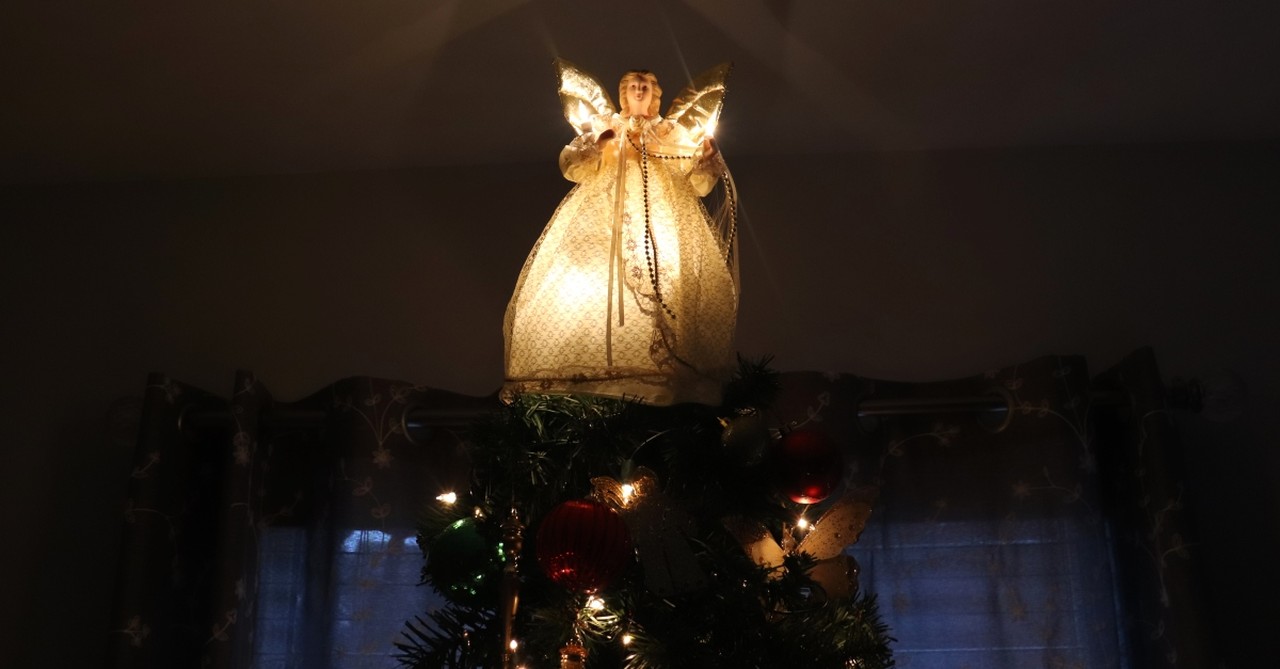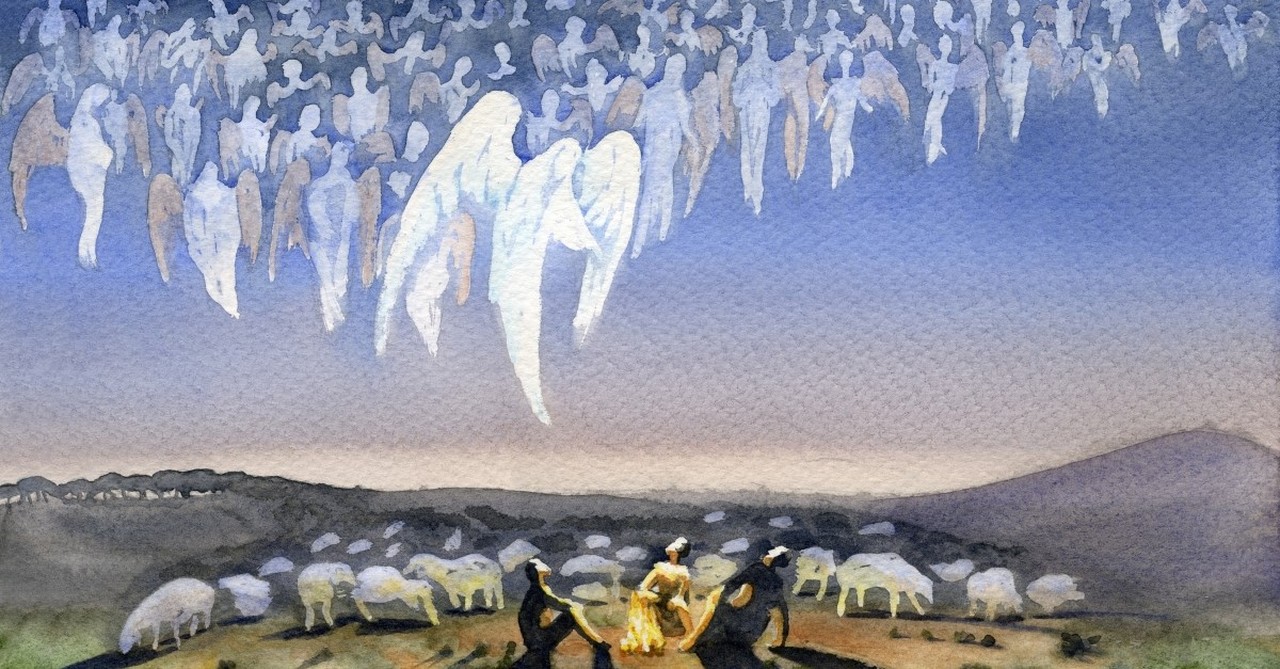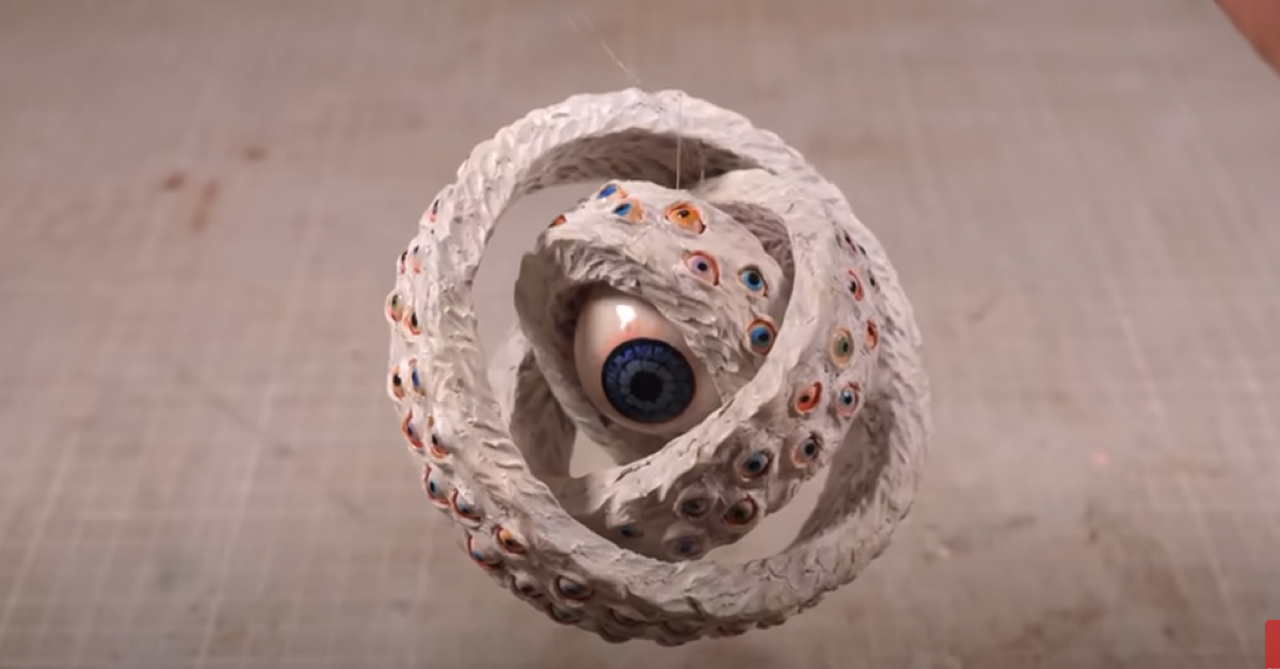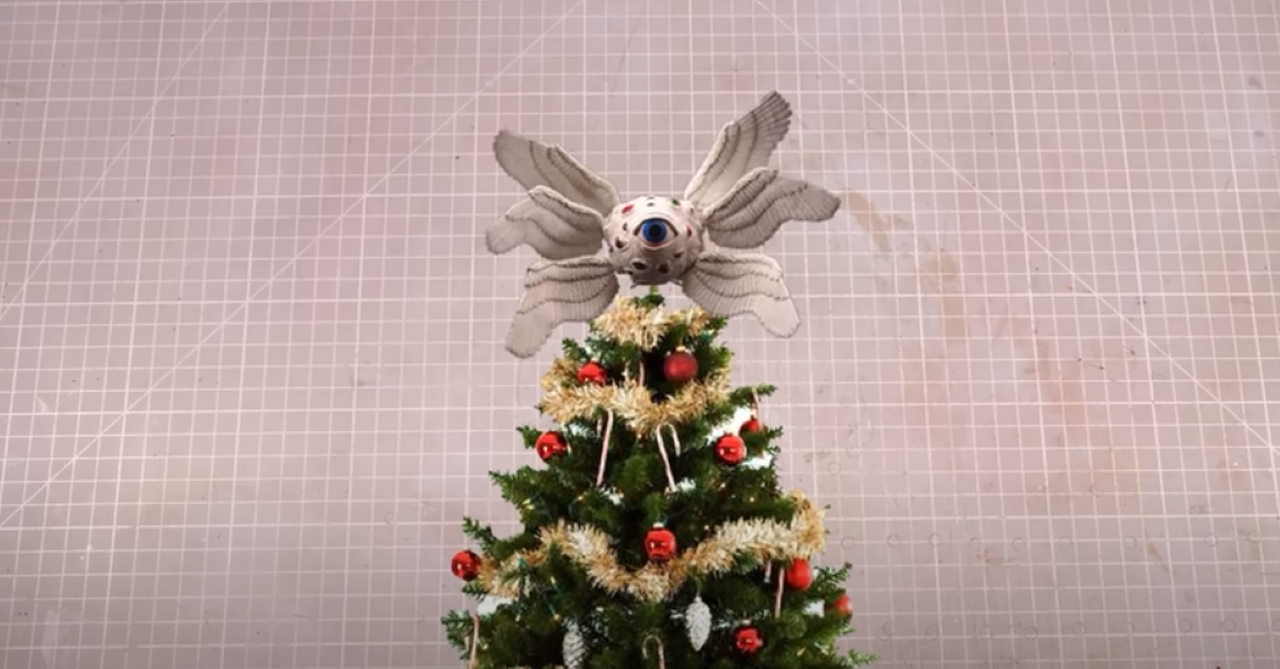
The tradition of decorating Christmas trees has been an essential part of the holiday season for centuries. At the top of many Christmas trees sits an angel – a symbol of the heavenly hosts who announced the birth of Jesus to the shepherds on that first Christmas night. For many people, these angelic tree toppers are gentle, comforting figures with serene expressions, soft robes, and delicate wings. However, a surprising trend has emerged in recent years, driven by viral memes and internet culture: using biblically accurate angels as Christmas tree toppers.
These biblically accurate angels are far from the cute and comforting cherubs people have grown accustomed to seeing on Christmas trees. Instead, they’re mysterious, awe-inspiring, and sometimes so frightening that they tell people who see them not to be afraid. These angels, as described in the Bible, can feature multiple wings, eyes covering their bodies, and wheels within wheels. The resurgence of interest in these otherworldly beings challenges the traditional view of angels.
Here’s why biblically accurate angel Christmas tree toppers will surprise you, and why decorating your Christmas tree with biblically accurate angels has spiritual value.
Photo Credit: ©iStock/Getty Images Plus/Phil Vargas
Cherubim Angels in the Books of Genesis, Ezekiel, and Revelation

Cherubim Angels in the Books of Genesis, Ezekiel, and Revelation
SLIDE 1 OF 5
The Bible describes cherubim angels, who guard God’s glory, as looking like extremely powerful beings that are nothing like cherubs – the babies with wings that people often place on their Christmas trees. In Genesis 3:24, the Bible shows cherubim angels guarding the Garden of Eden after humanity’s fall: “After he drove the man out, he placed on the east side of the Garden of Eden cherubim and a flaming sword flashing back and forth to guard the way to the tree of life.” One of the most detailed descriptions of cherubim angels in the Bible comes from the prophet Ezekiel, in chapters 1 and 10 of the Book of Ezekiel.
In Ezekiel 1:4-28, the prophet Ezekiel reports a vision he had by a river, which includes seeing cherubim angels in action. Verses 5 through 14 report: “… in the fire was what looked like four living creatures. In appearance their form was human, but each of them had four faces and four wings. Their legs were straight; their feet were like those of a calf and gleamed like burnished bronze. Under their wings on their four sides they had human hands. All four of them had faces and wings, and the wings of one touched the wings of another. Each one went straight ahead; they did not turn as they moved. Their faces looked like this: Each of the four had the face of a human being, and on the right side each had the face of a lion, and on the left the face of an ox; each also had the face of an eagle. Such were their faces. They each had two wings spreading out upward, each wing touching that of the creature on either side; and each had two other wings covering its body. Each one went straight ahead. Wherever the spirit would go, they would go, without turning as they went. The appearance of the living creatures was like burning coals of fire or like torches. Fire moved back and forth among the creatures; it was bright, and lightning flashed out of it. The creatures sped back and forth like flashes of lightning.”
The Bible also describes the powerful and complex cherubim angels in Revelation 4:6-9: “…In the center, around the throne, were four living creatures, and they were covered with eyes, in front and in back. The first living creature was like a lion, the second was like an ox, the third had a face like a man, the fourth was like a flying eagle. Each of the four living creatures had six wings and was covered with eyes all around, even under its wings. Day and night they never stop saying: ‘Holy, holy, holy is the Lord God Almighty,’ who was, and is, and is to come. Whenever the living creatures give glory, honor and thanks to him who sits on the throne and who lives for ever and ever.”
Photo Credit: © Getty Images/ OlgaPtashko
Ophanim Angels in the Book of Ezekiel

Ophanim Angels in the Book of Ezekiel
SLIDE 2 OF 5
In Ezekiel’s vision, the Bible also describes ophanim angels, who emphasize God’s wisdom. These angels are described as wheels intersecting one another, covered in eyes, and moving in perfect harmony with the cherubim.
Ezekiel 1:15-24 describes: “As I looked at the living creatures, I saw a wheel on the ground beside each creature with its four faces. This was the appearance and structure of the wheels: They sparkled like topaz, and all four looked alike. Each appeared to be made like a wheel intersecting a wheel. As they moved, they would go in any one of the four directions the creatures faced; the wheels did not change direction as the creatures went. Their rims were high and awesome, and all four rims were full of eyes all around. When the living creatures moved, the wheels beside them moved; and when the living creatures rose from the ground, the wheels also rose. Wherever the spirit would go, they would go, and the wheels would rise along with them, because the spirit of the living creatures was in the wheels. When the creatures moved, they also moved; when the creatures stood still, they also stood still; and when the creatures rose from the ground, the wheels rose along with them, because the spirit of the living creatures was in the wheels. Spread out above the heads of the living creatures was what looked something like a vault, sparkling like crystal, and awesome. Under the vault their wings were stretched out one toward the other, and each had two wings covering its body. When the creatures moved, I heard the sound of their wings, like the roar of rushing waters, like the voice of the Almighty, like the tumult of an army. When they stood still, they lowered their wings.”
Ezekiel 10:9-13 also describes ophanim angels in a similar way. Ophanim angels reflect God’s ability to see and know everything, eternally.
Photo Credit: Youtube / North of the Border
Seraphim Angels in the Book of Isaiah

Seraphim Angels in the Book of Isaiah
SLIDE 3 OF 5
In Isaiah chapter 6, the prophet Isaiah describes his vision of God seated on a high and exalted throne, surrounded by seraphim angels leading worship in heaven. Verses 2-4 reveal: “Above him were seraphim, each with six wings: With two wings they covered their faces, with two they covered their feet, and with two they were flying. And they were calling to one another: ‘Holy, holy, holy is the Lord Almighty; the whole earth is full of his glory.’ At the sound of their voices the doorposts and thresholds shook and the temple was filled with smoke.”
The seraphim are depicted as burning beings with six wings. Two wings cover their faces to shield them from the overwhelming glory of God, two cover their feet as a sign of humility, and two are used for flight. The seraphim’s voices are so powerful that they cause the very foundations of the temple to tremble. This conveys the scary majesty of these heavenly beings, who glorify God and guard holiness. The term “seraphim” is derived from a Hebrew word meaning “to burn,” reflecting their fiery and purifying nature. These angels show that encounters with God are not always comforting; they’re so powerful that they can sometimes be scary.
Photo Credit: Youtube / North of the Border
Why Cherubs Became Christmas Decorations

Why Cherubs Became Christmas Decorations
SLIDE 4 OF 5
The modern perception of angels as gentle, humanoid figures is a relatively recent development in the history of religious art. During the Renaissance (the 14th through the 17th centuries), artists like Raphael, Michelangelo, and Botticelli redefined the image of angels. The church, which was a significant patron of the arts, encouraged depictions of angels that were comforting and accessible, rather than the more challenging depictions of biblical angels.
Renaissance artists invented cherubs – angels that looked like chubby babies with angels and were inspired by the classical putti in ancient Roman art. These figures symbolized the innocence and purity of love in action. Renaissance artists favored the cherub-like depictions of angels because they fit well within the emerging ideals of humanism, which emphasized the beauty of the human form. This artistic reinterpretation not only made religious art more appealing to the masses but also helped the church communicate its messages more effectively. Over time, these soft, gentle angels became the standard, overshadowing the more complex and intimidating descriptions found in the Bible.
By the 19th and 20th centuries, the cherubic image of angels became synonymous with Christmas for many people. In Victorian England, people started using cherub angel ornaments to decorate the top of Christmas trees. The Victorians embraced a romanticized view of angels, favoring depictions that showed the warmth and comfort of the Christmas season. This tradition of cherub Christmas tree toppers was passed down through generations, and today, many people still decorate their trees with cherubs. However, this softened image of angels is a far cry from the awe-inspiring beings described in the Bible. Cherubs are a comforting illusion – a way for people to try to domesticate the divine. But God – and his angels – are far too powerful and mysterious to shrink down to a comforting size.
Photo Credit: ©Getty Images/Stratos Giannikos
The Spiritual Value of Biblically Accurate Angels

The Spiritual Value of Biblically Accurate Angels
SLIDE 5 OF 5
Biblically accurate angels confront us with the reality that God and his angels are not always easy to understand or accept. Decorating with these angels might make a statement that faith is not just about comfort – it’s also about challenge, growth, and a willingness to be surprised by God.
The Christmas season is an important time to discover and reflect on the wonder of God’s work around you. The shepherds did just that on the first Christmas. When they encountered the angelic hosts who announced Jesus’ birth, they weren’t comforted; they were terrified. Yet their fear turned to joy when they understood the message of hope and salvation the angels proclaimed. Biblically accurate angels remind us that encounters with God are not always comforting. Instead, encountering God often involves holy mysteries that inspire us with awe. By embracing the Bible’s exotic and strange depictions of angels, we open ourselves up to a deeper appreciation of the mysteries of faith.
These angels, with their many eyes, wings, and faces, symbolize aspects of God’s nature that are beyond human comprehension. They remind us that faith is not just about comfort; it’s about grappling with the unknown and lifelong learning. A biblically accurate angel on our tree can start conversations about the nature of angels, the meaning of biblical symbolism, and the deeper truths of our faith.
In conclusion, the trend of decorating Christmas trees with biblically accurate angel toppers invites you to take a fresh look at how the Bible truly describes angels, challenging the sanitized depictions that have dominated Christmas traditions for centuries. By embracing the reality of angels as described in the Bible, you can be inspired by the true wonder of God’s angelic messengers! Perhaps this Christmas season you will say goodbye to the cherubs, and let your Christmas tree reflect the majesty and mystery of the angels as they were originally meant to be seen!
Photo Credit: ©Getty Images/MinoruM

Originally published November 11, 2024.







